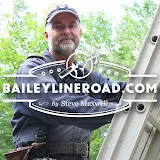0:00
We're almost 30 feet off the ground here on some scaffolding and it's a special day
0:21
In 1987, I laid the first stone in the basement foundation of this house
0:28
And I'm kind of embarrassed to say that it's taken me 31 years to get this far, but this
0:33
particular stone you see here is quite significant. It's the date stone
0:37
I'm going to be setting this and I wanted to let you see that
0:42
This is a special time. I didn't think it was going to take this long
0:45
As I said, I'm kind of embarrassed it's taken me this long, but in my defense, I have financed
0:49
a household of seven people. We have five kids now, all of which came along since I started this project
0:55
And after this stone, I probably have four or five more stones to go and then it will
1:17
The last thing to do when you're setting any stone or when I'm setting stones here is to
1:22
do the pointing. And I've gone with an old style here. All old stonework, traditional structural stonework that I've seen has mortar joints
1:33
that cover the edges of the stone. This tool is kind of interesting
1:36
It was given to me by an old stonemason. He was born in 1909
1:42
His name was Ivan Bailey. I've written about him many times actually
1:47
And this is one of the tools that he'd use to make this line profile here
1:53
So for most stones, it actually takes just as long to do the pointing as it does to set
1:57
the stone. So I'll put a little more mortar in there later
2:04
And now I'm just, I'm just connecting these lines. I mean, they don't look all that important close up, but far away, it really changes
2:14
the look of the stonework. And now it's the time for the, this vertical one
2:31
Well I'm about to lay the last stone. I'm going to take you up in the scaffolding and show you how that works
2:35
It's a little different than regular stones, but I've been, I've got the last load of mortar
2:41
here and it's in a special wheelbarrow. This is a wheelbarrow I haven't used for years because it's getting kind of old and feeble
2:48
but it is the wheelbarrow that Mary and I built the house with
2:53
So the vast majority of mortar was mixed and dumped into this wheelbarrow
2:59
Stones were moved before I had running water. When I was living in the shed, I used to take baths in that wheelbarrow on Saturday nights
3:08
and I figured the last load of mortar should be transported by this wheelbarrow since it's
3:14
been with us from the start. So as you see, it's kind of messy, but I'm going to rebuild it when we're all done, but
3:19
I wanted it in its original condition for this particular operation. So the mortar goes on this hoist I've built here and I'll see you up top
3:33
Okay, so I've got the last stone here and it's very different than any other stone I've
3:37
laid in the house, except for the other peaks. It's got to fit between the soffit here, and of course once the stone is in place
3:49
I can't grab it and move it and set it. So I've drilled a hole here for this masonry screw, which gives me a handle
4:00
And I'm going to be tipping the stone back and moving it back like this, laying in some
4:05
mortar and then lifting the stone up and pulling it forward by the handle and setting it down
4:10
on the mortar. I'm going to let that harden and then the very last thing to do is to come up a couple
4:15
of days from now and take this screw out. The hole won't be visible, it's too small, so I'm going to get to it
4:23
Okay, now that's way more mortar than we need, but that's just what I want because it lets
4:34
me wiggle it down here
4:52
Really awkward here because I don't have very much room at all
5:03
Lucky for me, it's kind of hard to see what's going on down below
5:10
That's it. All done. Go to Beadaholique.com for all of your beading supply needs


